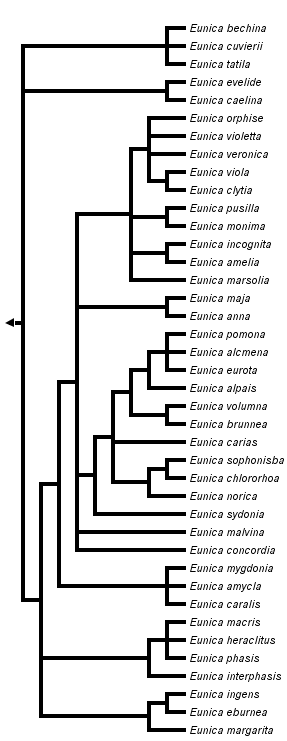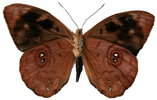Eunica
Andrew V. Z. Brower and Niklas Wahlberg


This tree diagram shows the relationships between several groups of organisms.
The root of the current tree connects the organisms featured in this tree to their containing group and the rest of the Tree of Life. The basal branching point in the tree represents the ancestor of the other groups in the tree. This ancestor diversified over time into several descendent subgroups, which are represented as internal nodes and terminal taxa to the right.

You can click on the root to travel down the Tree of Life all the way to the root of all Life, and you can click on the names of descendent subgroups to travel up the Tree of Life all the way to individual species.
For more information on ToL tree formatting, please see Interpreting the Tree or Classification. To learn more about phylogenetic trees, please visit our Phylogenetic Biology pages.
close boxIntroduction
The genus Eunica was extensively revised by Jenkins (1990), who also included a cladistic analysis of 55 morphological characters. Species of Eunica are found mainly in South America with a few species found in Central America and the Greater Antilles. The genus comprises 40 currently accepted species (Lamas 2004). The host plants have been recorded for only a few species, but in line with other species in Biblidinae, these are in the plant families Euphorbiaceae and Burseraceae.
Characteristics
According to Jenkins (1990) the diagnostic features of Eunica are:
- Male uncus with a terminal small, usually separate, extended and curved beak
- Male tegumen elongate and often constricted posteriorly
- Male gnathos reduced, narrowed or shortened, rarely with a gnathos arm and rarely fused or joined ventrally
- Forewing with base of costa somewhat angled
- Male wings black or brown usually marked or glossed with iridescent blue, females dimorphic, usually brown with white maculae or band on forewing
Discussion of Phylogenetic Relationships
The phylogenetic hypothesis for Eunica is based solely on morphological characters at the moment. The tree has a consistency index of 0.40, meaning that many of the characters are homoplasious. Clearly more data (both morphological and molecular) are needed to corroborate the relationships shown. The study by Jenkins (1990) did have several well-supported results. First, he showed that the species Eunica cuvierii (previously placed in the monotypic genus Libythina) belongs in Eunica. Several of the clades in the tree above are supported by unique synapomorphies.
References
Jenkins, D. W. 1990. Neotropical Nymphalidae. VIII. Revision of Eunica. Bulletin of the Allyn Museum 131:1-175.
Lamas, G. (ed) 2004. Atlas of Neotropical Lepidoptera. Checklist: Part 4A, Hesperioidea - Papilionoidea. Scientific Publishers, Gainsville, Florida.
Title Illustrations

| Scientific Name | Eunica viola |
|---|---|
| Location | Peru |
| Specimen Condition | Dead Specimen |
| Identified By | Niklas Wahlberg |
| Sex | Male |
| View | underside |
| Image Use |
 This media file is licensed under the Creative Commons Attribution-NonCommercial License - Version 3.0. This media file is licensed under the Creative Commons Attribution-NonCommercial License - Version 3.0.
|
| Copyright |
© Niklas Wahlberg

|
| Scientific Name | Eunica eurota |
|---|---|
| Location | Pantanal, Brazil |
| Specimen Condition | Live Specimen |
| Identified By | Kim Garwood |
| Life Cycle Stage | adult |
| View | dorsal |
| Source | Eurota Purplewing |
| Source Collection | Neotropical Butterflies |
| Copyright | © 2003 Kim Garwood |
About This Page

Middle Tennessee State University, Murfreesboro, Tennessee, USA
Niklas Wahlberg

University of Turku, Finland
Correspondence regarding this page should be directed to Andrew V. Z. Brower at and Niklas Wahlberg at
Page copyright © 2006 and Niklas Wahlberg
 Page: Tree of Life
Eunica .
Authored by
Andrew V. Z. Brower and Niklas Wahlberg.
The TEXT of this page is licensed under the
Creative Commons Attribution License - Version 3.0. Note that images and other media
featured on this page are each governed by their own license, and they may or may not be available
for reuse. Click on an image or a media link to access the media data window, which provides the
relevant licensing information. For the general terms and conditions of ToL material reuse and
redistribution, please see the Tree of Life Copyright
Policies.
Page: Tree of Life
Eunica .
Authored by
Andrew V. Z. Brower and Niklas Wahlberg.
The TEXT of this page is licensed under the
Creative Commons Attribution License - Version 3.0. Note that images and other media
featured on this page are each governed by their own license, and they may or may not be available
for reuse. Click on an image or a media link to access the media data window, which provides the
relevant licensing information. For the general terms and conditions of ToL material reuse and
redistribution, please see the Tree of Life Copyright
Policies.
- First online 04 October 2006
- Content changed 25 July 2008
Citing this page:
Brower, Andrew V. Z. and Niklas Wahlberg. 2008. Eunica . Version 25 July 2008 (under construction). http://tolweb.org/Eunica/70457/2008.07.25 in The Tree of Life Web Project, http://tolweb.org/









 Go to quick links
Go to quick search
Go to navigation for this section of the ToL site
Go to detailed links for the ToL site
Go to quick links
Go to quick search
Go to navigation for this section of the ToL site
Go to detailed links for the ToL site